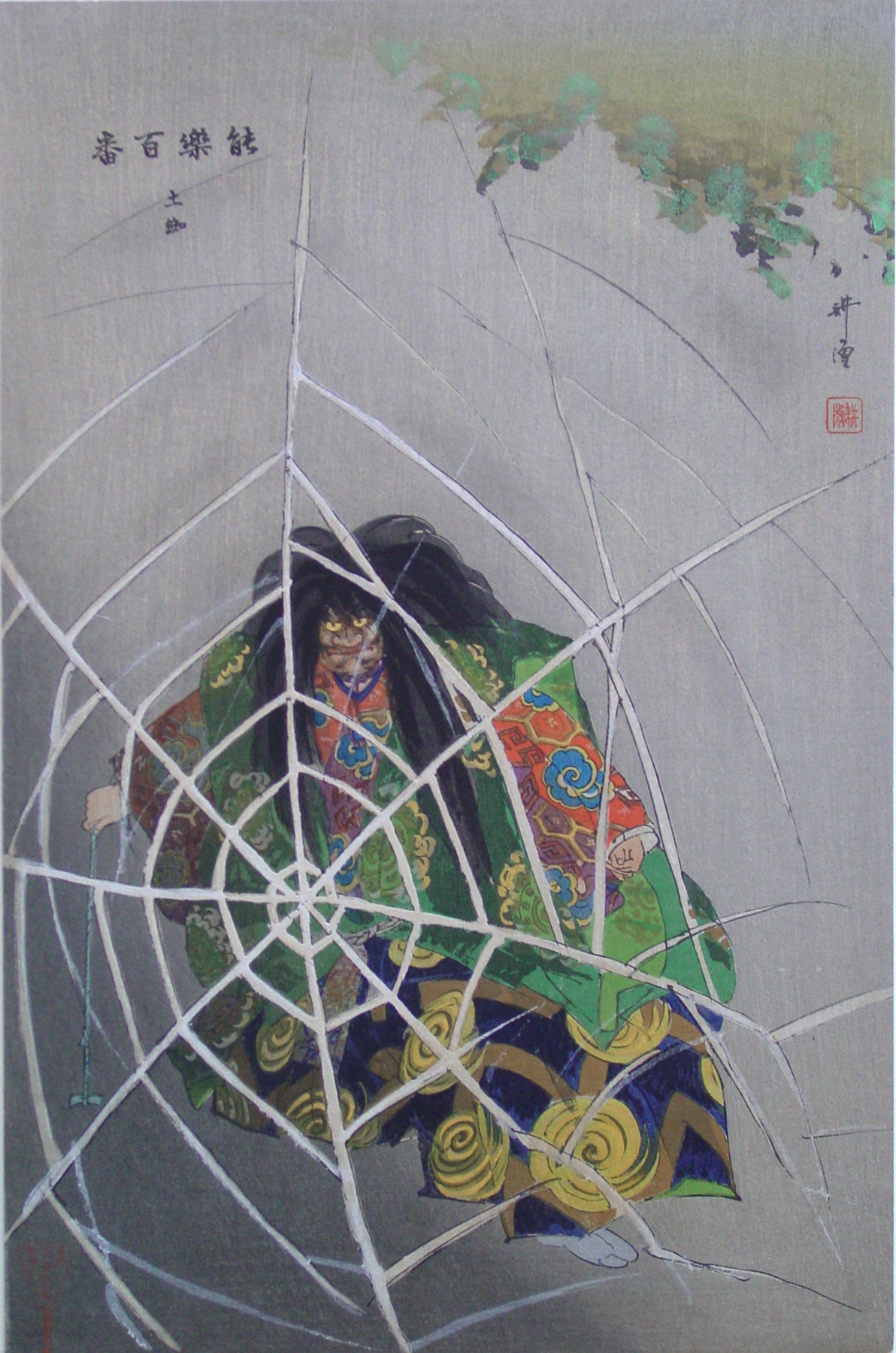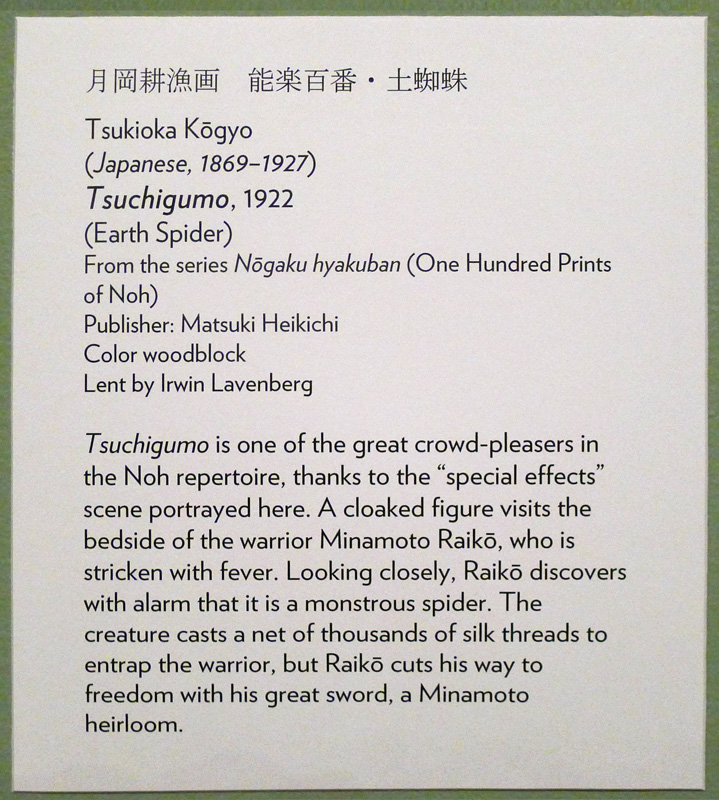About This Print
One of 120 prints issued as part of the series Nōgaku hyakuban (One Hundred Prints of Noh), it depicts a scene from the play Tsuchigumo by an unknown playwright in which the shite throws spider threads made of Japanese paper to snare the warrior Minamoto Raikō (Minomoto no Yorimitsu.) This print was originally released by the publisher Matsuki Heikichi in the sixth installment of prints in this series. This series' prints were offered in monthly installments consisting of three prints packaged in an envelope with additional descriptive information.1For another depiction of this play by the artist see Nōgakuzue, Tsuchigumo.
The servant Kochō comes bringing prescribed medicine to Minamoto no Raikō, who is ill in bed. However, his illness becomes more and more serious.
Deep in the night after Kochō leaves, an unknown monk visits the bedridden Raikō and inquires about his condition. Suspicious, Raikō asks the name of the monk, and the monk approaches Raikō reciting a poem in the Kokin-shū, "my love will visit me tonight, because a spider…" Looking closely, Raikō finds that it is a monstrous spider. Although the spider spins out thousands of silk threads to tie Raikō up, from his pillow side Raikō takes the great sword Hiza-maru, which has been passed down within the Genji clan. When he draws the sword and cuts the monster, the spider monk disappears instantly.
Hitorimusha, a warrior who serves Raikō, hears the commotion and rushes to Raikō's room with many of his followers. Raikō tells about the event and announces that he will change the name of the great hereditary sword from Hiza-maru to Kumokiri (Spider Slasher). Then Raikō tells Hitorimusha to exterminate the monstrous spider as he could not give it a death blow.
Hitorimusha and other servants follow the blood spots of the monstrous ground spider to an old mound, which seems to be the nest of the spider. The ground spider appears when they demolish the mound. The ground spider gives them trouble with its silk threads. However, Hitorimusha's entourage encircle it in strength and finally slay it.
Special Exhibition
NOH Dance Drama of the Samurai NOV 17, 2012 – FEB 24, 2013
The Play - Tsuchigumo (Earth Spider)
Source: The Noh.com website http://www.the-noh.com/en/plays/data/program_002.htmlThe servant Kochō comes bringing prescribed medicine to Minamoto no Raikō, who is ill in bed. However, his illness becomes more and more serious.
Deep in the night after Kochō leaves, an unknown monk visits the bedridden Raikō and inquires about his condition. Suspicious, Raikō asks the name of the monk, and the monk approaches Raikō reciting a poem in the Kokin-shū, "my love will visit me tonight, because a spider…" Looking closely, Raikō finds that it is a monstrous spider. Although the spider spins out thousands of silk threads to tie Raikō up, from his pillow side Raikō takes the great sword Hiza-maru, which has been passed down within the Genji clan. When he draws the sword and cuts the monster, the spider monk disappears instantly.
Hitorimusha, a warrior who serves Raikō, hears the commotion and rushes to Raikō's room with many of his followers. Raikō tells about the event and announces that he will change the name of the great hereditary sword from Hiza-maru to Kumokiri (Spider Slasher). Then Raikō tells Hitorimusha to exterminate the monstrous spider as he could not give it a death blow.
Hitorimusha and other servants follow the blood spots of the monstrous ground spider to an old mound, which seems to be the nest of the spider. The ground spider appears when they demolish the mound. The ground spider gives them trouble with its silk threads. However, Hitorimusha's entourage encircle it in strength and finally slay it.
Noh performance of Tsuchigumo, Kanze Tetsunojō VIII
Copyright 1998-2008, Global Performing Arts Consortium. All Rights Reserved.
1 “The series Nogaku hyakuban (100 No plays) by Tsukioka Kogyo (1869-1927),” Claus-Peter Schulz, Andon 67, Society for Japanese Arts, p. 28.
Copyright 1998-2008, Global Performing Arts Consortium. All Rights Reserved.
1 “The series Nogaku hyakuban (100 No plays) by Tsukioka Kogyo (1869-1927),” Claus-Peter Schulz, Andon 67, Society for Japanese Arts, p. 28.
Print Details
| IHL Catalog | #153 |
| Title | Tsuchigumo 土蜘蛛 (Earth Spider) |
| Series | Nōgaku hyakuban 能楽百番 (One Hundred Prints of Noh or One Hundred Noh Plays) |
| Artist | Tsukioka Kōgyo (1869-1927) |
| Signature | Kōgyo |
| Seal |  Kōgyo, seal no. 36, p. 171 in The Beauty of Silence: Nō and Nature Prints by Tsukioka Kōgyo (1869-1927), Robert Schaap & J. Thomas Rimer, Hotei Publishing, 2010. Kōgyo, seal no. 36, p. 171 in The Beauty of Silence: Nō and Nature Prints by Tsukioka Kōgyo (1869-1927), Robert Schaap & J. Thomas Rimer, Hotei Publishing, 2010. |
| Date | August 1922 |
| Edition | unknown |
| Publisher | Matsuki Heikichi (Daikokuya) |
| Carver | |
| Impression | excellent |
| Colors | excellent |
| Condition | good - backed and trimmed |
| Genre | nishiki-e; nōgaku zue 能樂圖繪 [Noh play picture] or 能絵 [Noh-e] |
| Miscellaneous | Portland Art Museum loan number L2012.113.10 |
| Format | oban tate-e |
| H x W Paper | 14 5/8 x 9 1/2 in. (37.1 x 24.1 cm) |
| Collections This Print | San Francisco Fine Arts Museum 1997.125; Scripps College 2007.1.75; Art Institute of Chicago 1939.2258.38; Ritsumeikan Art Research Center arcUP1415; Japan Arts Council BK026-053 |
| Reference Literature | The Beauty of Silence: Nō and Nature Prints by Tsukioka Kōgyo (1869-1927), Robert Schaap & J. Thomas Rimer, Hotei Publishing, 2010, pl. 65, p. 117. |




